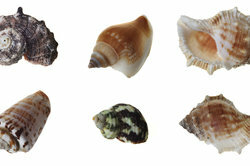Where do snails live?
You don't need to ask a gardener this question. He finds the animals wherever it is damp, preferably on fresh lettuce leaves or other young plants. However, that is only a small part of the truth, because the multiform beings colonize almost every possible habitat.

Snails (Gastropoda) can survive in the depths of the seas, on the banks of rivers and lakes, in the midst of roaring surf and on the bottom of dried up rivers. They have proven to be extremely adaptable.
Marine life in brackish water or in the deep sea
- You will find a wide variety of shapes, especially among the species that live in the sea. There are those who swim around freely without a shell, some who look like a clam and still others who stick with their strong feet on the rock in the strongest surf.
- The limpets belong to the latter. You can find these species with the bowl-shaped shell sucked onto stones along the Atlantic coast, in the North Sea and in the Mediterranean. Surely you have already spotted the common limpets (Patella vulgata) on rocks by the sea.
- The shell snails, to which the Friesian button (Gibbula cineratia) belongs, have similar, but more tower-shaped shells. The name already suggests that you can also find this species on German coasts. It needs a rocky subsoil at a depth of about 100 meters. You can find their housing on the island of Helgoland.
- Wherever periwinkles live is already yours Names to recognize. The genus Littorina occurs in the flood limit and also in the surf zone of algae. Different species are known on our native coasts. The common periwinkle (Littorea littorea) is also found on the Baltic coast. The animals can be found both under the water and below sea level.
- Famous species of the tropical seas are the porcelain snails, also known as cowrie shells. They live in coral regions and feed on algae, sponges and tiny animals. In the past, the porcelain-like cases were used as currency. The two main species used as currency are Cypraea annulus and C. moneta. The purple snails (Murex) also come from tropical seas. Some of the species used to be used to extract the color purple for precious royal robes.
Worm - lifespan
It is well known that the life of a snail proceeds in a calm path. Proverbial is ...
Snails on rivers and lakes
- Species that frequently live in freshwater in Central Europe are pond snails. With their toothed tongue, the radula, which is typical of all gastropods, they grate underwater plants and are very resistant. Once the water dries up, they withdraw into their housing and close it with a lid. Many species of snails can use this strategy to survive dry spells.
- Other animals common in freshwater are posthorn, mud, cap and bladder snails. The great ramshorn snail (Planorbarius corneus) prefers calm, plant-rich waters. You can often find this species in northern Germany.
- You will not find amber snails in, but in the immediate vicinity of rivers and lakes, most commonly the species Succinea putris. Everywhere at ditches and lakes on the ejected mud and on the surrounding plants or reeds you will find the small animals with amber-colored housings.
Life on land - common snails
- Representatives who live on land are certainly the best known, as we meet them everywhere, in the city, in the villages, in the forest, in the garden and on meadows. Many land snails are so common that we are inclined to include only these species in the gastopoda group.
- Our local Roman snail (Helix pomatia) is revered as a delicacy, but is now protected in the wild. Well-known animals with a shell are the snail snails. The animals feel at home everywhere between dense vegetation, where it is damp and somewhat shady.
- This also applies to the nudibranchs, which are feared in the garden. The species of snails (Limex) or slugs (Arion) can be found in the grass, between leaves and under hedges, especially after rain.
- The largest animals living on land can be found in Africa. They are agate snails (Achatina), the shells of which are up to 20 centimeters high. Locals appreciate the meat, weighing half a kilogram in a single animal. A completely different species also belongs to this group, the blind snail (Caecilioides acicula), which is also native to Central Europe. The animals live underground up to 40 centimeters below the ground or under stones. The missing eyes gave it its name.
How helpful do you find this article?

